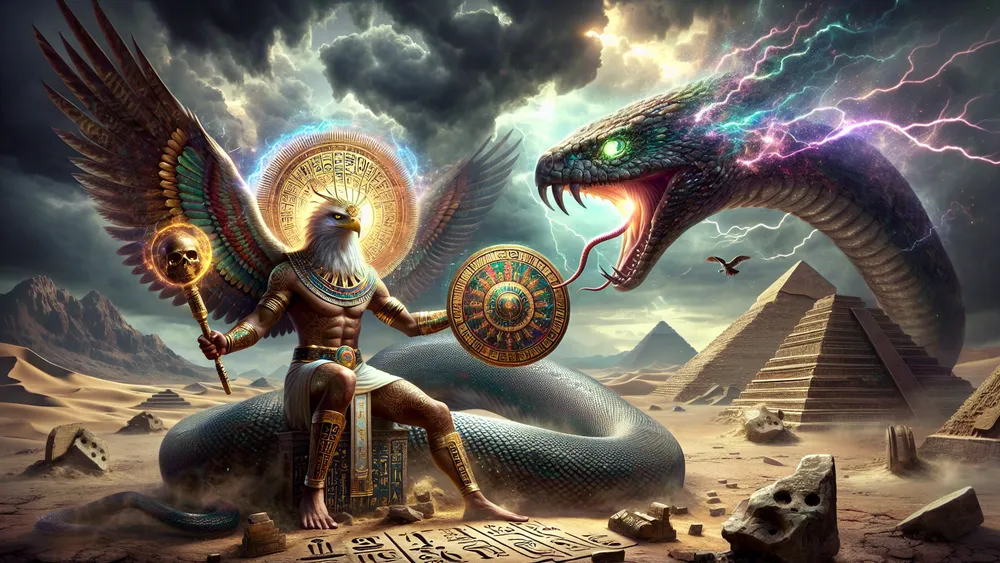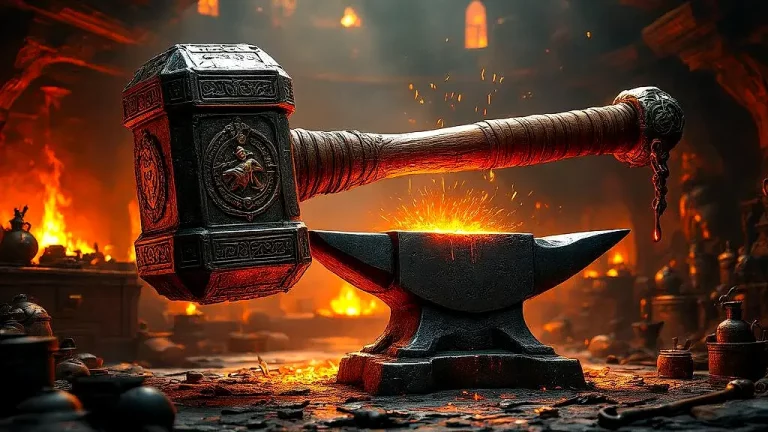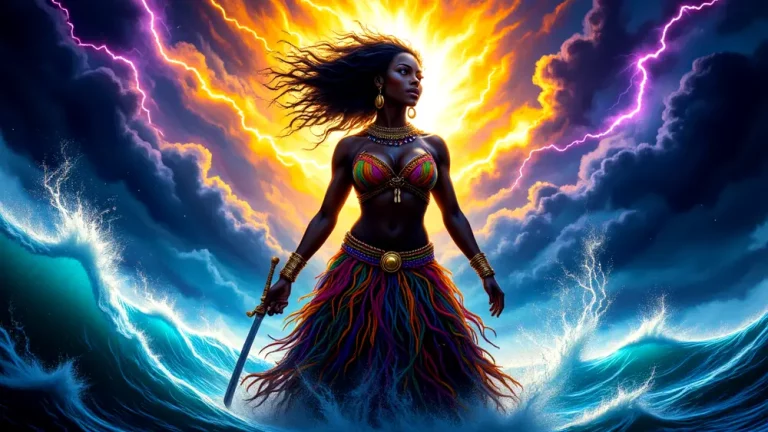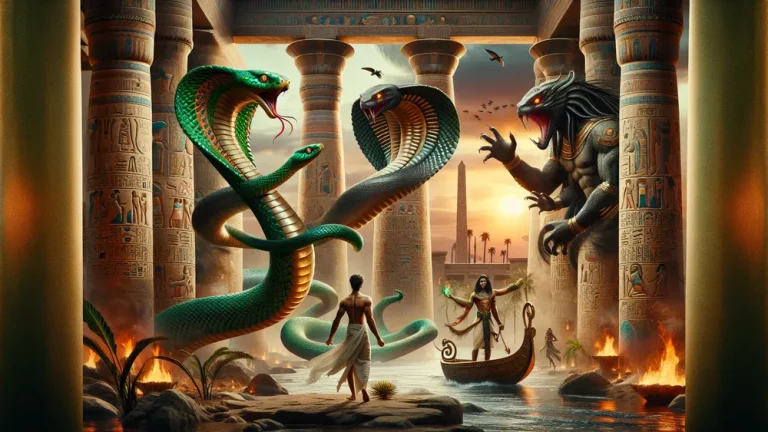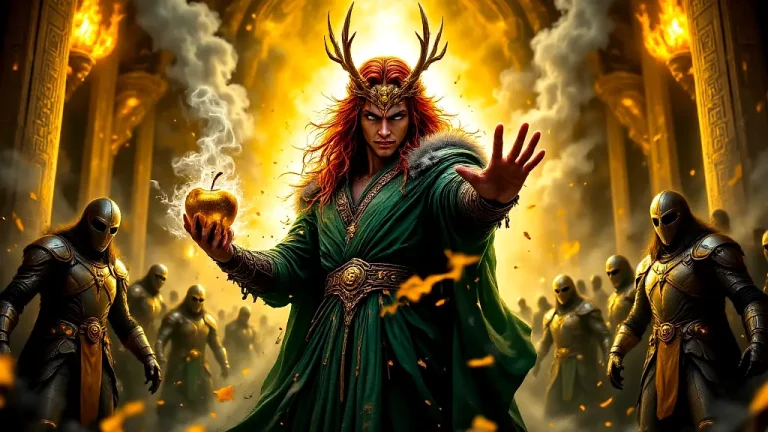End Of The World In Egyptian Mythology: A Mythic Perspective
Greetings to a curious trip into the bottom of Egyptian myths, where we will look at old Egyptians’ strange views on how everything ends. Picture a place where each night the sun fights a snake of craziness, and gods step in to keep us from being destroyed.
Key Points:
- Egyptians viewed the end of the world as a cyclical event of chaos and renewal, unlike a final apocalypse.
- The nightly battle between Ra, the sun god, and Apophis, the chaos snake, symbolized the ongoing struggle between order and chaos.
- Hathor transforming into Sekhmet and nearly wiping out humanity showed the gods’ power to create and destroy.
- Protective spells, rituals, and temple activities were crucial in preventing the end of the world in Egyptian mythology.
- Egyptian mythology has influenced modern stories, such as books, movies, and video games, reflecting themes of cosmic struggles.
- New archaeological discoveries, like the Book of Two Ways and temple writings, deepen our knowledge of ancient Egyptian beliefs about the end times.
In this write-up, you will find out how the Egyptians thought of the end times – a thing named eschatology – and how it is not like other people’s end-of-the-world ideas. We will get into main stories and gods, like the every night fight between Ra and Apophis, plus the anger of Hathor turning into Sekhmet.
You will also see the signs of craziness and order, the importance of the sun, and the things done to stop cosmic problems. Lastly, we will talk about how these old ideas have shaped today’s end-of-the-world tales and what new found things show about these forever stories. Come along as we figure out the puzzles of the Egyptian ending, giving you a full and interesting understanding of this cool topic.
End Of The World In Egyptian Mythology: Overview and Key Facts
| Main Idea | Explanation |
|---|---|
| End-Times Study | Learning about how the Egyptians thought of the end and what would happen to people. |
| Chaos Snake (Apophis) | The big snake of disorder tries to stop Ra, the sun god, every night making everything dark. |
| Sun God (Ra) | The god of daylight who stands for order and making things, fights chaos so daylight happens. |
| Hathor/Sekhmet | Hathor, a goddess of fun and kindness, changes into Sekhmet, a lioness goddess of ending things, in a tale where she almost wipes out humans. |
| Neferti’s Saying | An old saying that tells of a time full of chaos then order comes back, showing time cycles in Egyptian thoughts. |
| Signs of Chaos and Order | Things like the sun for order and snakes for chaos show the ongoing fight between these powers. |
| Sun Disappears | Seen as signs of chaos, where the sun going away briefly meant Apophis had a small win. |
| Safety Spells and Words | Actions and spells done by old Egyptians to keep away chaos and make sure the sun comes back each day. |
| Priests and Holy Places | Priests did daily tasks in holy places to keep cosmic order and stop the world from ending. |
| Modern Effects | Egyptian end tales changed today’s end stories in books, movies, and in what people like. |
| New Finds | Digs and discoveries giving new knowledge into old Egyptian end beliefs and actions. |
The Idea of the End of the World in Egyptian Mythology
To figure out how the old Egyptians thought about the end times, we must look into their strange beliefs and stories about this idea.
A Look at Egyptian End of the World Beliefs
Egyptian end-of-the-world thoughts are about studying how everything ends and what happens to people, but unlike other groups, the Egyptians saw this idea as a loop. Whereas groups like Christianity think of a straight line that ends in a final judgment, Egyptians believed in a never-ending loop of chaos and order, similar to how seasons change. You can see this looping nature in their stories, where every night the sun god Ra fights the chaos snake Apophis to make sure the sun appears each morning. For you to understand these beliefs better, some important terms and ideas connected to Egyptian end thinking are given here:
- Ma’at: The idea of cosmic balance and order.
- Isfet: The idea of chaos and disorder.
- Ra: The sun god connected to making things and order.
- Apophis (Apep): The chaos snake trying to bring darkness.
- Sekhmet: The lioness goddess of breaking things, showing possible chaos within the divine order.
By knowing these key terms, you can understand the different view the ancient Egyptians had about how the world ends.
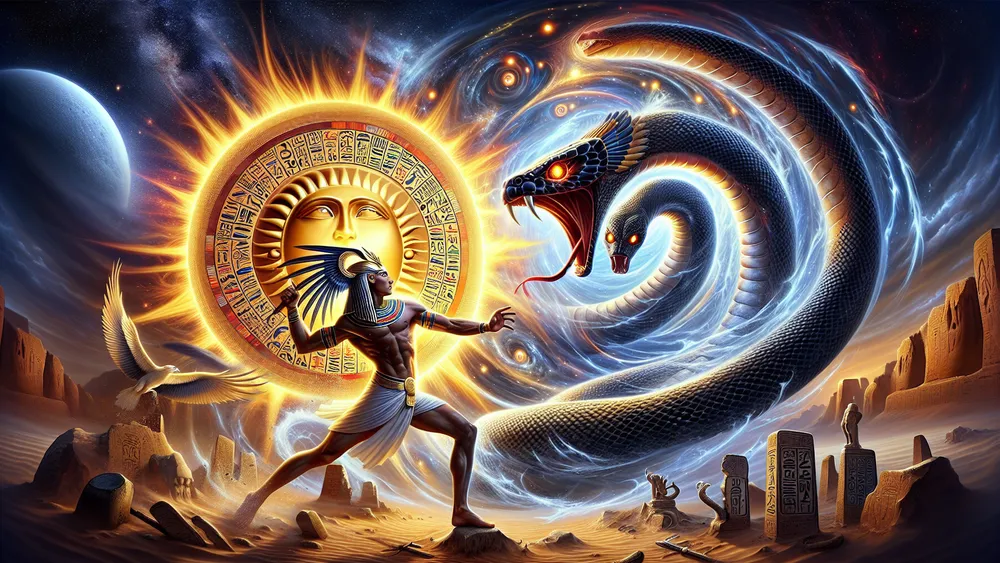
Ancient Egyptians viewed the world’s end as a continuous cycle of chaos and order, with key concepts like Ma’at, Isfet, Ra, Apophis, and Sekhmet illustrating their unique beliefs.
Key Myths and Deities in the World’s End Stories
To look deeper into the Egyptian idea of the world’s end, you need to check out the main stories and gods that are important in these tales.
The Part of Apophis
Apophis, called Apep too, is a big character in Egyptian stories, showing chaos and messiness. Stories say Apophis is a huge snake living in the world below, always trying to mess up the order made by the gods. Unlike many gods with temples and followers, Apophis is just bad, showing the opposite of Ma’at, the idea of order.
His start is mysterious, but he is often shown as a massive snake or dragon, meaning chaos is always a threat.
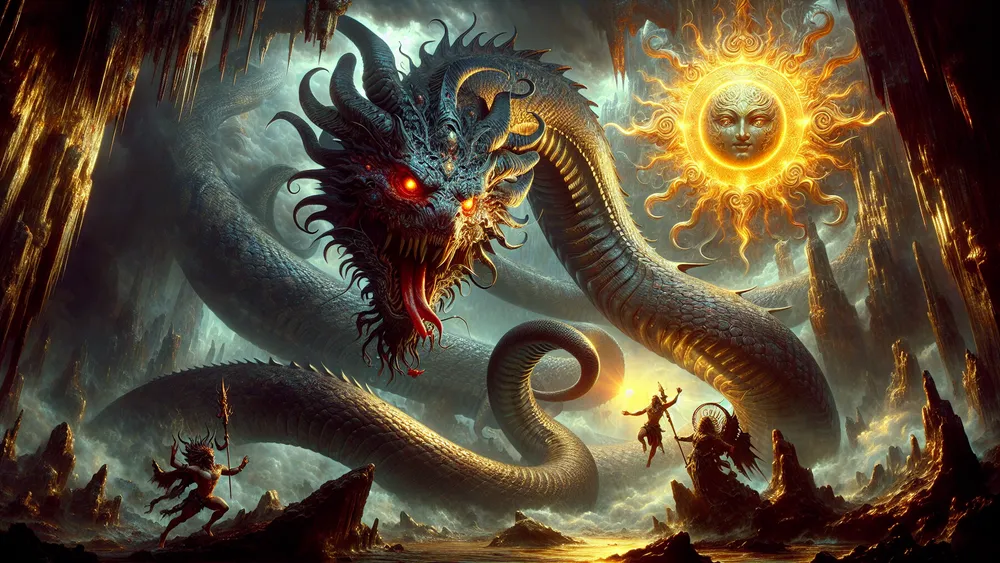
Each night, a very fierce fight happens between Apophis and Ra, the sun god, as Ra goes through the underworld on his sun boat. Apophis tries to eat the sun, causing endless night. But, Ra, with help from gods like Set and Bastet, fights Apophis off, making sure the sun comes back every morning. This nightly battle shows the never-ending fight between order and chaos, which is very important in Egyptian thinking. To help you get the importance of Apophis, there are main fights and events with this chaos serpent:
- The Nightly Battle: Apophis tries to eat the sun while Ra is in the underworld.
- The Solar Eclipse: Seen as a short win for Apophis over Ra, causing temporary darkness.
- The Rituals of Protection: Spells and tricks done by priests to help Ra against Apophis.
- The Role of Set: Set, the storm and chaos god, is often shown as Ra’s helper in fighting Apophis.
By knowing these main events, you can understand the big impact Apophis had on how Egyptians saw the world, always showing the constant threat of chaos that gods and people need to keep fighting against.
The Wiping Out of Humanity Story
The story of Hathor’s anger and almost ending humanity is among the most exciting tales in Egyptian stories. The story says that the sun god Ra got upset with humans because they were being disrespectful and unfaithful. So, full of anger, he sent his daughter Hathor, who turned into Sekhmet, the lioness goddess who destroys things, to punish humans.
Sekhmet went on a wild rampage, killing many people, nearly wiping out all humans. Her thirst for blood was extreme, threatening to end humanity.
Seeing how serious things were, other gods came up with a plan to save humans. They made a lot of beer and mixed it with red clay to look like blood, then poured it over fields. Sekhmet thought the beer was blood and drank it, getting drunk and eventually falling asleep. This smart trick stopped her, and she turned back into Hathor, the kind goddess of love and happiness. This story shows how Egyptian gods can both make and destroy. To help you get the most important parts and characters of this story, here is a summary:
| Important Event | Details |
|---|---|
| People Disrespect Ra | Humans betray and upset Ra, which makes him angry. |
| Turning into Sekhmet | Hathor changes herself into Sekhmet to punish humans. |
| Sekhmet’s Rampage | Sekhmet’s thirst for blood almost destroys all of humanity. |
| Gods’ Plan | Gods use beer with red clay to calm Sekhmet. |
| Turning Back to Hathor | Sekhmet gets drunk and changes back to Hathor, saving people. |
By understanding these important events, you can see how complex Egyptian stories are and the fine balance between order and chaos that the gods tried to keep.
The Prediction of Neferti
The prophecy by Neferti is a significant story in Egyptian tales, told by a wise man named Neferti who predicted a time of big trouble followed by getting back to normal. This prophecy says Egypt would go through a time of mess with social troubles, natural problems, and the breaking down of Ma’at, the idea of world order. But Neferti also said that a king would rise to fix everything and bring a new time of wealth. This story was both a warning and a promise, showing the repeated pattern of order and chaos in Egyptian thinking. To help you get the important parts of Neferti’s prophecy, here is a summary:
- Time of Chaos: Predicated social troubles and natural problems.
- Fall of Ma’at: Said the world order would fall apart.
- Savior-King: A future ruler who would bring back balance.
- Order’s Return: The coming back of wealth and calm.
By knowing these main points, you can see how deep Egyptian end-of-world beliefs are and how they focus on the repeated fight between disorder and order.
Symbols and How We Understand Them
To fully grasp how Egyptians thought about the end of the world, it is important to look at the symbols they used to show these deep ideas.
Symbols of Chaos and Order
In Egyptian tales, chaos and order are shown by many strong symbols that show the never-ending fight between these two forces. Chaos is often shown by the snake Apophis, meaning disorder and ruin, which threatens the safety of the universe. Meanwhile, order is shown by Ma’at, who stands for truth, balance, and world peace. We see these ideas clearly in stories like the nightly fight between Ra and Apophis, where Ra winning keeps everything in order. To help understand these symbols better, here is a list of key symbols and what they mean:
- Apophis (Apep): Means chaos and ruin.
- Ma’at: Stands for truth, balance, and world order.
- Ra: The sun god, means life and order.
- Sekhmet: In her wild form, shows the chance for chaos.
- The Feather of Ma’at: Means justice and balance in the universe.
By knowing these symbols, you can see better how the old Egyptians thought about the thin line between chaos and order, especially when thinking about the end of the world.
Understanding the symbols of Apophis, Ma’at, Ra, Sekhmet, and the Feather of Ma’at helps reveal how ancient Egyptians viewed the delicate balance between chaos and order in their world.
The Importance of the Sun and Eclipses
In Egyptian stories, the sun is very important. It is shown by Ra, the sun god, who means life, order, and the daily cycle of rebirth. Ra’s trip across the sky each day and his fight each night against the bad forces, especially the snake Apophis, show the ongoing struggle to keep the world’s order. But solar eclipses were seen as scary times when chaos took over order for a bit, making the old Egyptians very afraid. They thought these eclipses meant Apophis was winning, and they did big ceremonies to make sure Ra won and balance came back. To help you get why these events mattered in myths, here is a list of important solar eclipses and what they meant:
- Eclipse of 2134 BCE: Thought to show Apophis winning for a short time over Ra.
- Eclipse of 1302 BCE: Seen as a sign of coming chaos and disorder.
- Eclipse of 1223 BCE: Meant to show a main fight between Ra and Apophis.
By getting what these meanings were, you can see how big a role sky events had on the old Egyptians’ views and how they tried to keep world peace.
What They Did to Prevent the End of the World
Grasping these symbols and sky events is important, but it’s also necessary to see what steps the old Egyptians took to stop the world’s end.
Protective Spells and Incantations
For keeping away the forces of chaos, the old Egyptians used many protective spells and sayings, thought to have strong magical powers. These spells were often written on amulets, tomb walls, and papyrus scrolls, working as shields against bad beings like Apophis. They performed rituals very carefully to make sure the sun came back every day, which they saw as crucial for keeping the universe in order. For instance, every morning, priests said special words to help Ra travel across the sky, ensuring he came out as the winner from his night fight with chaos. Here is a list of important spells and what they did:
- Spell of the Twelve Caves: Protected dead people from dangers in the underworld.
- The Liturgies of Ra: Said to make sure the sun god’s safe trip through the night.
- The Book of the Dead: A group of spells to guide and protect souls after death.
- The Apophis Book: Spells aimed at beating Apophis and stopping chaos.
Knowing these protective ways, you can see how much the old Egyptians did to keep order and stop the world from ending.
What Priests and Temples Did
Priests in old Egypt were very important for keeping cosmic order by doing rituals and ceremonies with great care. Acting as go-betweens for the gods and the people, they made sure the divine rules were followed so chaos could be avoided. Temples, which were not just places to worship but models of the universe, were at the heart of these ritual activities. These holy places where priests did daily offerings, recitations, and ceremonies were essential for honoring the gods and keeping the balance of Ma’at. Here is a list of major temples and what they did:
- Temple of Karnak: Known for the Opet Festival, celebrating the renewal of kingship and cosmic order.
- Temple of Luxor: Site of the Beautiful Feast of the Valley, a ritual to honor the dead and ensure their safe passage to the afterlife.
- Temple of Philae: Dedicated to Isis, where rituals focused on fertility and protection.
- Temple of Edfu: Center for the annual re-enactment of Horus‘s victory over Seth, symbolizing the triumph of order over chaos.
Knowing the roles of priests and the meaning of temples, you can appreciate the detailed efforts the old Egyptians made to keep harmony and stop the world from ending.
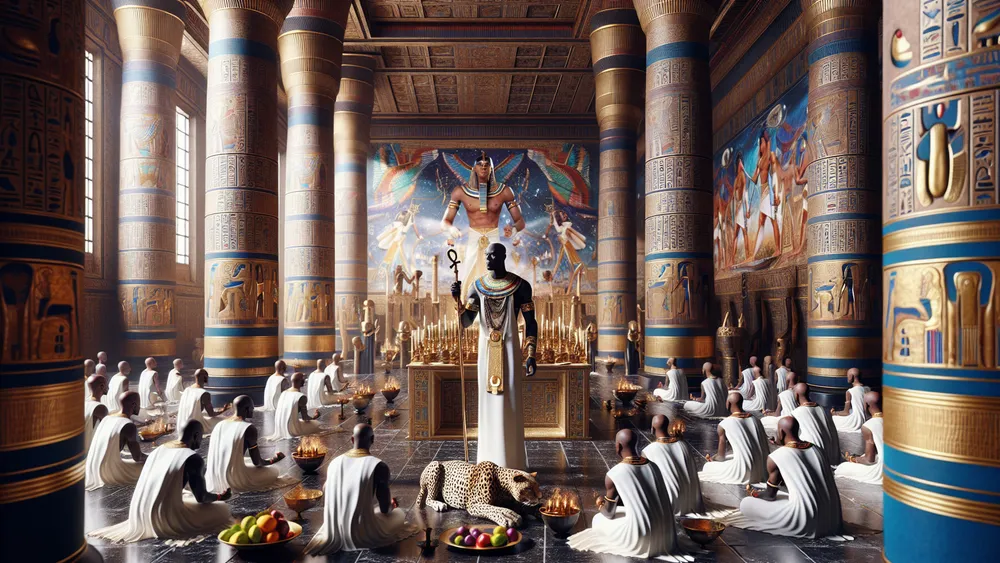
Modern Takes and Impact
After looking at old practices and beliefs, it is interesting to see how these myths and rituals have changed modern views and cultural stories.
How It Shaped Modern End-of-the-World Stories
Egyptian myths about the end of the world have left a lasting mark on today’s stories about the apocalypse. These myths bring together ideas of chaos, cosmic fights, and divine help into modern tales. For example, the idea of a cosmic struggle between order and chaos, shown by the nightly fight between Ra and Apophis, is found in modern apocalyptic stories where heroes fight against overwhelming odds to bring back balance.
In books, Rick Riordan’s “The Kane Chronicles” takes a lot from Egyptian mythology, using gods and old spells in a modern setting. In movies, films like “The Mummy” series talk about the comeback of old evils and the chaos that follows. Popular culture also shows these influences, with video games like “Assassin’s Creed Origins” putting players in a world full of Egyptian myths. Here is a list of notable works that Egyptian mythology has influenced:
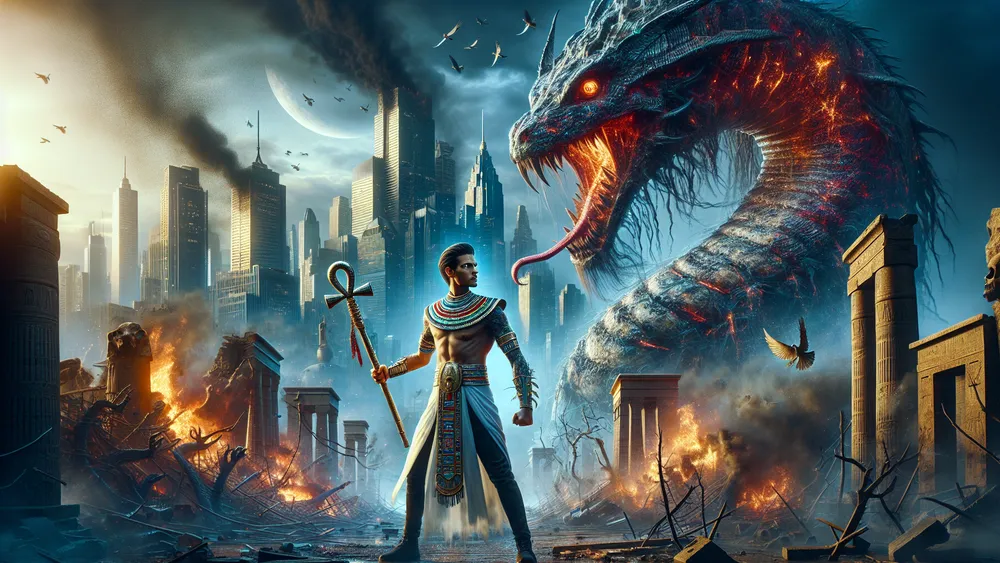
- “The Kane Chronicles” by Rick Riordan: A book series that mixes Egyptian gods and myths with modern adventures.
- “The Mummy” franchise: Movies about the comeback of ancient Egyptian curses and their effects on today’s world.
- “Assassin’s Creed Origins”: A game exploring ancient Egypt and its myths thoroughly.
- “Stargate”: A sci-fi series using Egyptian gods and symbols in its story.
Looking at these examples, you can see how Egyptian mythology still inspires and shapes today’s stories about the apocalypse.
New Finds and What They Mean
New archaeological finds have made our knowing of Egyptian end-of-the-world ideas much deeper; they give new chances to see old beliefs about the end times. For example, finding the “Book of Two Ways” in a Middle Kingdom coffin has given brand-new thoughts on the Egyptian idea of the afterlife and the soul’s path. Similarly, fresh temple writings offer unknown rituals designed to fight chaos and keep cosmic balance.
These finds do not just grow what we know but also challenge old views, showing how complex and deep Egyptian end-time thoughts were. To help you understand what these finds mean, here is a table summarizing key discoveries and their importance:
| Discovery | Importance |
|---|---|
| “Book of Two Ways” | Details the afterlife journey and protective spells. |
| Temple Writings at Abydos | Shows new rituals to keep cosmic balance and fight chaos. |
| Tomb of Wahtye | Gives details on burial practices and afterlife beliefs. |
| Pyramid Texts at Saqqara | Oldest known religious texts, explaining the king’s afterlife journey. |
When you look at these finds, you can see how new archaeological work keeps adding to our knowing of ancient Egyptian end-time ideas and how much these ideas shaped their view of the world.
FAQs
1. Did the ancient Egyptians believe in a final apocalypse?
The ancient Egyptians did not believe in a final apocalypse but rather in cyclical events of chaos and renewal.
2. How did the Egyptians try to prevent the end of the world?
To prevent the end of the world, the Egyptians performed protective spells, incantations, and rituals to maintain cosmic order and ensure the sun’s daily rebirth.
3. What role did the sun play in Egyptian end-of-the-world myths?
The role the sun played in Egyptian end-of-the-world myths was central, as its daily rebirth symbolized the ongoing battle against chaos and the maintenance of cosmic order.
4. How have modern interpretations of Egyptian mythology evolved?
Modern interpretations of Egyptian mythology have evolved to incorporate contemporary themes and perspectives, often blending ancient beliefs with modern storytelling techniques.

